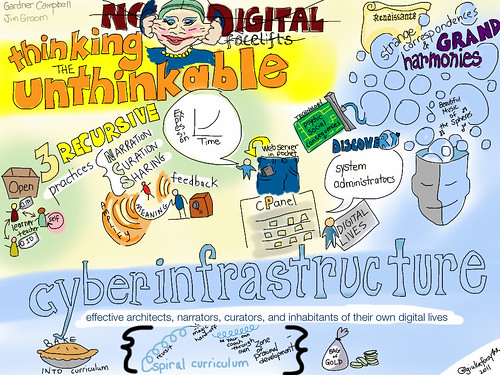It was exciting to see the class get engaged in tonight’s discussion from Gardener Campbell’s paper on Personal Cyberinfrastructure and his video recorded talk on this topic.
Students should be working on their reflection blog posts, but may want to wait to reference Gardner’s live appearance for the other da106 section (6pm EST can be viewed live at http://dtlttoday.com/live or archives posted later).
Below you will find the references I prepared for class. We touched on ideas of online identity, personality, and a lot on the tension between what can or cannot be done effectively in fully online classes. We heard of robotics and examples of possible digital facelifts (electronic textbooks? Government forms?).
Resources
A Personal CyberInfrastructure (from EDUCAUSE Review).
Cyberinfrastructure is something more specific than the network itself, but it is something more general than a tool or a resource developed for a particular project, a range of projects, or, even more broadly, for a particular discipline.
— American Council of Learned Societies,
Our Cultural Commonwealth, 2006
Higher education almost completely ignored Marshall McLuhan’s central insight: new modes of communication change what can be imagined and expressed. “Any technology gradually creates a totally new human environment. Environments are not passive wrappings but active processes. . . . The ‘message’ of any medium or technology is the change of scale or pace or pattern that it introduces into human affairs.” Print is not advanced calligraphy. The web is not a more sophisticated telegraph.
Just as the real computing revolution didn’t happen until the computer became truly personal, the real IT revolution in teaching and learning won’t happen until each student builds a personal cyberinfrastructure that is as thoughtfully, rigorously, and expressively composed as an excellent essay or an ingenious experiment.
Past ds106 posts on “Bags of Gold” http://ds106.us/?s=Bag+gold
Representations of highlights
Tom Woodward “Bag of Gold” audio remix jan 11 20011 http://bionicteaching.com/?p=1811
Tim Owens kinetic typography remix
Visual notes by Giulia Forsythe
Barbara Dieu made a mash up of her gold nuggets
Digital Facelift (Stella Meme)

Bag of Gold Blackboard remix Tom Woodward
http://bionicteaching.com/?p=1844
blog posts from last year
Matthew Presser disagrees with points on training wheels feb 2011 http://www.matthewpresser.com/blog/?p=49
Barbara Dieu felt it was a bit American focus, reflects on international perspective,
http://beespace.net/strange-correspondences-and-grand-harmonies/
It’s a radar…what part of that do you not understand?
“What sticks with me is the discussion about the old balloon system being replaced by the radar.
As Gardner puts it – “When radar was new it was found necessary to eliminate the balloon system for city protection that had preceded radar. The balloons got in the way of the electric feedback of the new radar information. The advanced defensive capabilities were stymied by the old defensive capabilities. Such may well prove to be the case with much of our existing school curriculum…”
Do we really need CyberInfrastructure D’Arcy Norman pushes back http://www.darcynorman.net/2011/01/18/bags-of-gold/
The Puzzle Of My Own Personal Cyberinfrastructure
Brad Kozlek http://bradkozlek.com/2011/01/the-puzzle-of-my-own-personal-cyberinfrastructure/
http://bradkozlek.com/2011/02/educators-the-digital-imagination-and-personal-cyberinfrastructure/



Add a comment